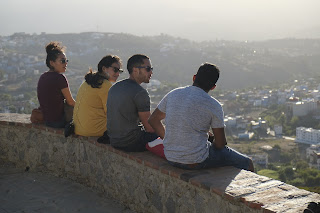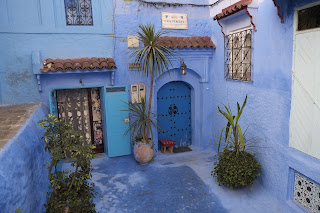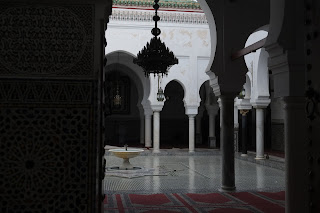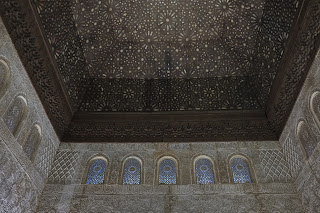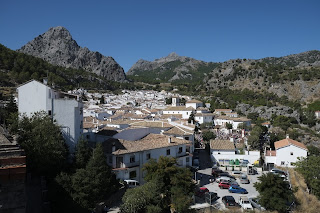It was overwhelming. The minute you set foot into the Médina, the chaos, the foreign scene and language, the hustling motorbikes speedily whistling by inches from your ankle from all sides. Don’t make any sudden movements, or they will hit you. Keep to the right at all times. Make yourself small. And you will be spared. But we made it. My hostel, through weaving lanes of packed people and stalls (I was glad I asked my hostel to send a driver/guide last minute), we passed through the large protective doors into the riad. Once inside, it was complete tranquility. A riad is a traditional Moroccan house inside the Medina, usually with an internal open courtyard, sometimes even a pool. It’s an unique part of the Moroccan tradition, but to be honest nowadays most are owned by foreigners who had turned them into beautiful enchanting guest houses, and I was lucky my hostel was one of these. Once you are inside one of these, I can see why people take a liking to this aspect of Morocco, and how writers and artists can feel inspired here. It seems, beyond the tense suffocating scenes of the Medina, there can be a surprisingly quiet, isolated, peaceful calm inside the walls. I can literally do nothing all day here but sit and stare into space, listening to the trickle of water from the fountain beside. I finally felt the impulse to crack open my book and start reading (a week and a half into my trip). At night, you can find yourself a nice little rooftop terrace at a cafe or restaurant, where once again you can be left with your own thoughts, the distance sound of motorbikes down below, staring into the perfect crescent that is the moon in a surprisingly transparent dimming North African night sky.
Marrakech is a bustling city. Outside the Medina walls stand a modern hub of busy streets and shopping districts of the ‘new town’. I was lucky to be able to meet my friend here, Amjad, whom I had met earlier in the year in Barcelona and bonded over football and photography. It was nice having his goofy smile with me as we toured some of the new part of the city back into the old. Marrakech feels relatively safe, amidst all the action. Tourism is its lifeblood, and apart from pocket thieves it seems people know not to mess with it. The main annoyance is the natural tendency of locals to try to take advantage of the many tourists, who also seems surprisingly comfortable lowering their guards as they weld their oversized expensive cameras into narrow alleys in all hours of the day and night. Everywhere you wander people are hustling to get you go into their shops, or worse, simply to “help lead” you to the main square for a tip (even if you are clearly NOT trying to get there). But most would eventually let up if you simply insist you are not interested in their services, and motor on with a determined and confident pace even if you have absolutely no idea where you are indeed heading.
For the rest of my Morocco trip, I had previously organized to join a tour with G Adventures. I usually prefer to travel alone, but I was honestly too lazy and last-minute to plan any of the logistics for this country. Plus, I don’t remember what little French I might have learned in school, and for the most part I just didn’t feel safe. I’ve had good experiences with G Adventures in my previous Northern Thailand / Laos trip, and once again this one did not disappointed as I got to spend 8 days with 11 wonderfully fun, respectful, social, and insightful fellow travellers. Together with our attentive guide and shy driver, we packed into a semi-comfortable (really not quite comfortable) mini-van to hit the many winding (and remarkably bumpy) roads of the country. I even learned a road trip game or two to pass the many hours of travel.
We started out in the intensely car-busy city of Casablanca, Morocco’s financial hub, which had little to offer for the average tourist although most international flights would land there. Quickly, we went north to Tangier (pronounced Tanger, actually), a fascinating city with its past as a somewhat unregulated international zone (where anything goes and anyone with a troubled past could come) as well as the main exit point for many African migrants hoping for a better life in Europe across the narrow straits (many of whom made Tangier an intermediate home until they figured out the means to cross over). Today, Tangier has revived itself as a tourist hotbed, while managed to hold on to its older charm. Next, we visited the surreal blue town of Chefchaouen, where an entire town is painted blue (various conflicting explanations were given) and tourists flock to take pictures of every single alleyway and doorway. We spent a rainy day there where some of us rewarded ourselves with a traditional Moroccan hammam (traditional bath house / massage) in between mint teas. When our eyes got tired of seeing blue, we went to Fez, one of the prettiest imperial cities of Morocco and home to numerous displays of extravagant Moorish architectures and patterns. The mosaics and tile work are quite exceptional, although most would argue that Spain’s Seville and Granada still hold the crown jewel of Moorish construction. It was too bad that our one day in Fez was again met with heavy rain, but it was still an unique experience to wander through narrow alleys of its claustrophobic (I’m not kidding) medina, while catching up on our souvenir shopping and practicing our bargaining skills (I still suck).
One of the recurrent themes in most Moroccan cities would be their medinas, but it was very interesting how they actually all feel quite different. Tangier’s medina has a very functional feel, as locals continue to use it to exchange their daily goods from food markets to used items to electronics to small corner stores. Chefchaouen’s medina is clearly dominated by the tourist market with rows of souvenir shops along its blue corridors, but if you wander off the beaten paths, you discover quiet undisturbed beautiful alleys where locals continue to live and thrive. Fez’s medina, although gigantic and narrow (only a few donkeys are allowed inside the medina at one time due to how narrow it’s lanes are), appears to be well organized in regions of leather production, silk lanes, metal works, women’s dresses, and so forth. And Marrakech’s medina, large and bustling with tourists, is filled with roars of motorbikes and uneven alleys and dead-ends. Getting lost in all of them is a fun, but somewhat courage-testing experience.
Finally, the food. Moroccan cuisine appears very heavy on a meat culture, as lamb, beef, and chicken form the mainstay, with the occasional restaurant serving goat, fresh fish (especially in Tangier), and exotic varieties such as kidney, brain (!!), and ox’s penis (!!!!) (none of us ordered the brain or penis, as much as I had encouraged them to do so). The consistent cooking theme is the Taijine, which is essentially slow cooking of the dish on a clay pot covered with a teepee like clay top while the sauce is reduced to a thick pureed like consistency. Excellent combinations were surprisingly simple such as chicken with olives, chicken in citrus sauce with toasted almonds on top, and lamb or beef in prune sauce and caramelized onions (awesome combo). Another stable is the couscous, usually served with a heaping portion of root vegetables with your choice of either of the above common meat items. For starters, they like a variety of cooked vegetable dishes, called mezzes, including spinach with chick peas, eggplants with spices, or fava beans, as well as a variety of bean or lentil based soup. Perhaps the most difficult of their dishes would be the chicken or beef pastilla (not to be confused with any form of pasta...). It's a complex mixture of minced meat with nuts then baked under a flaky shell and topped with sprinkles of cinnamon and sugar, resulting in a confusing array of sweet and savoriness that you're not quite sure if you are eating a main course or a dessert, but delicious none the less. And then of course there’s the endless supply of a variety of olives (the red ones were the tastiest followed by the usual green ones, while the black ones are often slightly bitter). Moroccan bread, often freshly baked daily in large plate size shapes, are everywhere, and is virtually eaten with everything. And after the meal, a mint tea. A nice hot, quite sweet, soothing drink of green tea with copious amounts of fresh mint leaves. It’s truly refreshing for any time of day really (in fact, sipping mint tea while sitting in an outdoor cafe and simply rudely people watch (or stare) seems to be a favorite activity of many Moroccan men.
But after about 20 days of living out of my backpack and hoping from one hotel room to the next, I’m quite ready to come home. I’m lucky to have seen some of the most prettiest places around on this trip, and got to cross off one big destination off my list that I’ve always wanted to see. The only slight regret is not having the time to venture further south into the shifting dunes of the Sahara (a bare minimum would have been a 3-day dessert camping trip from Marrakech). I have seen it once over a decade ago from the Tunisia side, but I believe the Moroccan dunes are far grander. But that will have to wait, for I have shifts to get back to. For now, dreams of a nice hot shower in the comfort of my own home awaits. I’ll eventually post many more photos of my trip. I’ve yet to sort through all my Barcelona photos, actually. But I will. I will. Signing off from Europe once again. Thanks again for reading!











